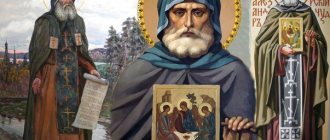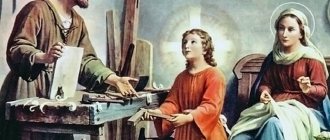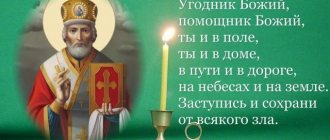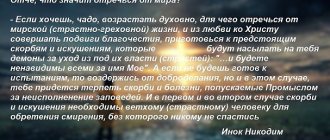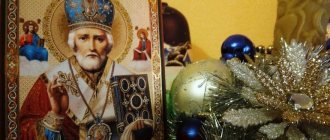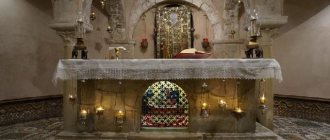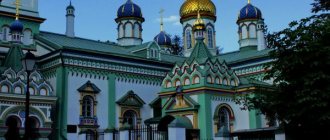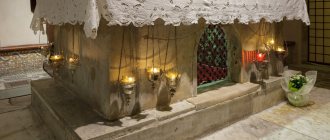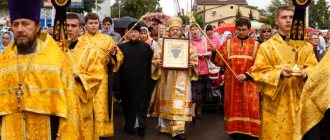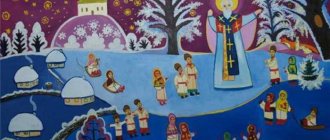The Chapel of Matthew of Yaransky is located in a small provincial town. The city of Yaransk, Kirov region, is located on the banks of the river. This is approximately 215 kilometers from the regional capital. Its area is 18.5 square meters. The first settlement was founded in 1591.
In 1708, the city was part of the Kazan province. About 500 Swedish captives settled on the outskirts of the village in 1711. And 1780 is the time when the status of a county town was assigned. They had their own meteorological station, a museum and a water supply system. The population began to increase rapidly.
Information about the city
At the beginning of the 20th century, the Prophetic Monastery began its activity. Hieromonk Matthew conducted monastic activities here. Soon an agricultural technical school opened in the city, and an association of peasant writers appeared. By 1963, the settlement was already part of the Kirov region. And in 2006, the settlement rightfully became the center of the Yaransky urban settlement.
Today it is an industrial town. There are many factories and enterprises operating here. Meat and alcoholic beverages are produced. It has its own sewing factory, elevator, food processing plant, and printing house. The area of the suburb is picturesque. The prevailing climate is temperate continental. Winters are characterized by low temperatures and there is a lot of snow. Summers are quite cool, with plenty of rain. The warmest month is July.
Yaransk is not only an industrial, but also a spiritual center of the Kirov region. There are many beautiful memorial places, springs, and temples. Pilgrims come here from various regions to enjoy the local beauty and bow to the icons.
About the chapel
The Chapel of Matthew of Yaransky is one of the most frequently visited places among believers. The brick, cubic monastery is distinguished by its modest design and small dimensions. The drum is small and topped with a graphite-colored dome. The building was built in 1990. It is located right next to the city cemetery. The shrine was built over the grave of Hieromonk Matthew, who was revered during his lifetime for his foresight. Pilgrims from Russia and neighboring countries come here to worship the great place. Matthew was canonized in 1997.
Wonderworker Venerable Matthew of Yaransky
The priest has been revered for 80 years. He was a great people's defender. Few of his contemporaries know about this amazing, insightful and kind man. There are many holy people in Russia. All of them help people with prayers and intercession before the Lord. They are an example for us, because the life of each of them is nothing other than the gospel of Christ. Matthew's earthly life took place during a difficult period in the Fatherland. Wars, disputes, and conflicts occurred at that time. The elder was born on May 23, 1855 in Vyatka. The baby was baptized in the Spaso-Khlynovskaya Church and named Mitrofan. The family was of bourgeois origin. There were six children in total. Mitrofan was the fourth. The family was believers. Everyone attended church every Sunday. Children were accustomed to worship from early childhood.
But one day the serene childhood ended. The head of the family, the father, suddenly died. Mitrofan was sent to study shoe making. But this activity did not bring him satisfaction. Ultimately, the young man never became a shoemaker. He became a clerk for the Vyatka merchant Stolbov. He lived with him for 18 years. The young man was able to perfectly master the trading business. The owner could trust him with the most important assignments. Thanks to Stolbov’s support, the young man was able to start a small farm for himself.
While in the service of a merchant, Matthew constantly needed spiritual support. In his search for her, he met the elder Hieroschemamonk Stefan (Kurteev). The young man liked the clergyman. He loved to talk to him for hours. And then one day the idea of stopping worldly activities and joining spiritual ones began to mature in his head. Stefan advised Mitrofan to learn prayer first. The guy listened to the mentor’s recommendations. In his store, he hung small notes with the text of the Jesus Prayer. He did this so that during the working week there would always be prayer before his eyes. He remembered his mentor’s words that without humility there would be no patience, so he tried not to rush things.
After a certain period, the monastery of the Holy Blessed Grand Duke Alexander Nevsky was opened. Mitrofan was then 35 years old. He decided to sell his store. The young man deposited the proceeds in the bank. In 1891, the Vyatka Spiritual Consistory decided to accept the young man as a novice at the Alexander Nevsky Monastery.
Father Matthew in the Alexander Nevsky Monastery worked conscientiously for the good of the church. About 8 years later, fame began to come to him. People began to treat the priest with love, since he was not indifferent to the problems of parishioners. He never refused advice and consolation.
People remember this interesting incident. One day a parishioner came to my father out of curiosity. She persistently asked him about what might happen to her in the near future. This woman's behavior was due to her curiosity. Her father listened carefully to her life story and tried not to interrupt. She even became angry with the priest in her heart, since he talked to everyone, but was silent with her. But then the clergyman came up to her and handed her three crackers, telling her to walk with God and advising her to pray a lot and be less lazy. Without blessing her, the priest simply left. The parishioner silently left the cell. But she could not understand what these three crackers meant.
Soon a misfortune befell her. Her home was completely burned down. She barely had time to rush out of the house. For three years, the woman lived in prayer, collecting alms from nearby settlements. And then the woman began to guess that this was how the priest foreshadowed trouble, but, most likely, he did not dare to tell the visitor the truth. Rather, the priest simply did not want to instill anger at God in the woman’s soul.
The year 1899 is significant because a monastery was built in honor of the late merchant Anna Dmitrievna Belyaeva. The illumination of the main altar took place in the name of Anna the Prophetess. Hieromonk Neil acted as the builder of the monastery. My father had many trials, but he did not lose strength and was distinguished by exceptional kindness to people. Today there is a bright memory of him. But the complex was growing and more help was needed. And then an assistant was sent to the Nile in the person of Matthew. My father devoted a lot of time to work here. In addition to worship services every day, it was necessary to do housework.
Venerable Matthew of Yaransky, hieromonk
In 1997, with the blessing of His Holiness Patriarch Alexy II of Moscow and All Rus' and the decision of the canonization commission at the Holy Synod of the Russian Orthodox Church, Yaran hieromonk Matthew was canonized as a venerable saint. “The Land of Vyatka has found another intercessor and prayer book at the Throne of Vyatka, along with the Monk Tryphon the Wonderworker of Vyatka, Blessed Procopius and Leonid of Ustnedum” - this was said in a special address to the Vyatka Orthodox people by Patriarch Alexy II of Moscow and All Rus'.
The word of the Primate of the Russian Orthodox Church was solemnly announced during the glorification, which took place in the city of Yaransk in September 1997. The glorification was led by the hierarchs of the Russian Orthodox Church, Bishop Chrysanthus - Archbishop of Vyatka and Slobodskaya, Bishop Alexander - Archbishop of Kostroma and Galich, Bishop John - Bishop of Yoshkar-Olinsk and Mari, Bishop Eugene - Bishop of Vereisky, Vicar of the Moscow Diocese.
In 1890, Mitrofan Kuzmich Shvetsov entered the Philei Alexander Nevsky Monastery as a novice, and a year later he was tonsured with the name Matthew and ordained as a hieromonk. In 1899, with the opening of the Yaran Prophetic Monastery, Fr. Matthew was sent as an assistant to the abbot. He performed the obediences of the treasurer, dean, confessor, and cell attendant. In 1921, the monastery was closed, and Hieromonk Matthew eventually moved to permanent residence in the village of Ershovo, not far from the village of Belyaeva. The same village in which Father Alexander (Konovalov) was born and raised. On May 29, 1927, Father Matthew died and, according to his will, was buried in the city cemetery in Yaransk.
Father Matthew began to show his gift of insight and healing, given to him by the Lord, during his lifetime; his fame spread not only throughout the Vyatka land, but also throughout the neighboring provinces. People came to him for help and advice during his life, and this flow did not stop even after death - people go to his grave, pray, and receive healing. Currently, 30 healings have been documented.
With the blessing of His Eminence Chrysanthus, Archbishop of Vyatka and Slobodsk, the earthly life of Hieromonk Matthew of Yaransky was studied in detail. These studies formed the basis of “The Life of St. Matthew of Yaran, the Wonderworker.”
Apparently, the compilation of the biography of Holy Father Matthew, and he was considered such by the people long before his official canonization, also began much earlier. At least back in 1994, Father Alexander (Konovalov) gave me the life of Father Matthew, typed on a typewriter. This happened in the village of Belyaevo, Kiknursky district. Belyaevskaya wooden church in honor of the saint and wonderworker Nicholas, which at the end of his life was visited by Fr. Matvey, was preserved in the most miraculous way - it was not touched by the hand of militant atheists. The stove in this church also stands in the same place, the stove behind which the elder found a place for himself during the service. In addition to his life, Father Alexander also gave me a photograph depicting Hieromonk Matthew with the brethren of the Yaran Prophetic Monastery.
When you have to go towards Shakhunya and you have some time left, turn to Yaransk and visit the grave of our Vyatka saint - St. Matthew, the Wonderworker of Yaran. It is located near the main entrance on the right hand. The grave is easy to find; a chapel was built over it in 1990 according to the design of the gifted Kirov architect Igor Genrikhovich Noskov.
In our Urzhum Holy Trinity Church, at the St. Nicholas chapel, on the lectern there is an icon of St. Matthew the Wonderworker of Yaran, and in the prayer to him there is the following appeal: “We humbly pray to you, Rev. Our Father Matthew. Now, together with the Monk Tryphon, blessed Procopius, the Vyatka lands, miracle workers and intercessors, and all the saints, offer up your powerful prayers to Christ, our Savior, and ask Him for confirmation of the Orthodox faith in our Fatherland, to the shepherds of zeal, monastics in good deeds of prosperity, pious and virtuous living to all Christians.”
V. ZorinSource: Urzhumskie Vedomosti
Prayers
Troparion, tone 1
From your youth you have loved Christ/ and sought Him with all your soul,/ keeping the commandments of God without laziness:/ by fasting, prayer and humility you have found the mercy of the Lord,/ you have acquired grace healings, Father, like Matthew./ Moreover, you were a good comforter who came running to you with faith: / Now we boldly pray to Christ / for the city of Yaransk and the people of the land of Vyatka, / to grant us fatherly affirmation of our faith // and salvation for our souls.
Kontakion, tone 8
By the purity of your life you have pleased the Lord, / you have acquired the gift of unceasing prayer, / the chosen one of God, like Matthew, Yaransky miracle worker: / we, who honor your holy memory, with love we cry out to you: pray to Christ God for the salvation of our souls.
At the beginning of the spiritual path
After the death of his father, the young man entered the service as a clerk for the Vyatka merchant Stolbov and lived with him for 18 years, showing considerable abilities in commerce and business management. With his gentle disposition, he gained the love and respect of those around him, and his owner eventually helped him open his own business.
Soon Mitrofan's store was decorated with numerous sheets of prayers so that they would always be in front of their eyes. The decision to devote himself to serving the Lord and to leave worldly vanities for a monastery gradually matured in Mitrofan’s heart.
During these same years, on his life’s path, he met an elder, Hieroschemamonk Stefan, in the world of Kurteev, who wisely and tactfully instructed him: “First learn heartfelt mental prayer, prudence, submission to the will of God; do not mistake your self for the call of God. Pray, humble yourself, and the Lord will tell you what to do.” And finally, in June 1891, Mitrofan came to the newly opened Phileisky Monastery. He was tonsured into the mantle and received a new name in honor of St. Matthew the Perspicious of Kiev-Pechersk. That same year he was ordained a hierodeacon, and six years later a hieromonk.
In 1899, the spiritual path led Hieromonk Matthew to the Holy Prophetic Monastery, ten kilometers from Yaransk. Its founder was Anna Belyaeva, from the merchant class, and the abbot, Hieromonk Nil, equipped the monastery. At first, Matthew served as a cell attendant, doing a lot of household work, for example, heating the monastery stoves, and later received a much more responsible obedience. He became the treasurer and housekeeper of the holy monastery, and here his worldly knowledge and skills were reflected when he worked for the merchant Stolbov.
He was endowed with the gift of clairvoyance, healing and miracles.
Those who met the elder described him as a handsome man, with an attentive, penetrating gaze, although Matthew usually walked with downcast eyes, completely immersed in prayer. No one ever heard him say a word of complaint or talk about vain topics. Having already gained fame, he always avoided it and led an abstinent lifestyle, preferring simple and modest food. At the same time, he was endowed with the gift of clairvoyance, healing and miracles.
After the October Revolution, the monastery was closed in 1921, and the monks were simply expelled from its territory. Matthew first huddled in the monastery apiary, and then in the village of Bolshaya Rudka and the village of Ershovo, Belyaevskaya volost. There, in a small hut built for him by local peasants, the old man lived until the end of his days.
In Ershovo there was a continuous flow of people coming to the elder for help, advice and spiritual strengthening from Udmurtia and Tataria, from Vyatka and from Perm, Nizhny Novgorod and Kostroma.
They said about Father Matthew that he often spoke allegorically, told parables, but it was always clear to the interlocutor what he was talking about. Appointed by His Holiness the Patriarch to the Yaran See, Bishop Nektary in the spring of 1925 appeared to Matthew secretly. When he was praying at Matthew’s home, the elder suddenly sang: “Thy martyrs, O Lord, in their suffering received incorruptible crowns from Thee, our God...” His words turned out to be prophetic: subsequently the bishop went through all the circles of hell in Stalin’s camps and was shot in September terrible year 1937.
